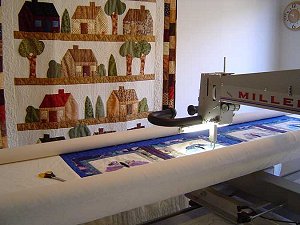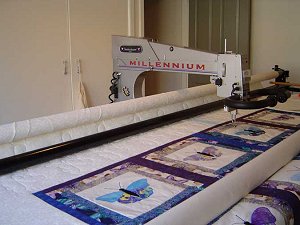
 What Happens at a Consultation
What Happens at a Consultation Quilting Considerations
Quilting Considerations The Quilting Machine
The Quilting Machine Attaching Borders
Attaching Borders Attaching Binding
Attaching Binding Local Shop List ‑ Melbourne
Local Shop List ‑ Melbourne


I have an APQS Millennium and an A-1, both of which have a stitch regulator. They are entirely hand guided - there is no computer and I cannot set it and walk away.
The machine is similar to a domestic machine in that it has a needle that goes up and down, a bobbin, and tension regulation.
The main differences between a long arm quilting machine and a domestic machine:
- A long arm machine has a much wider throat so more of the quilt can be worked on at one time.
- A long arm machine is on rollers on a long table so the quilt is stationery while the machine moves over the quilt.
- Because my machine has the stitch regulator feature, it will stitch even stitches by going faster as I move faster, and stopping if I stop.
The quilt layers are pinned onto tensioned rollers and held with clamps on the sides. This is why a minimum of 4 inches on each side is required for the backing and batting.
A section of the quilt is worked on at a time. When each section of the quilt is completed, the three layers of the quilt are rolled forward and the next section of the quilt is worked on.
The quilting can be done from both the front and the back of the machine.
When working from the front of the machine this is called freehand, and it is like drawing with stitches on the quilt. This is the type of quilting I specialise in.
When working from the back of the machine, patterns are followed with a laser light.
There are two types of machine quilting:
- Allover (or edge to edge)
- Custom
Allover designs cover the entire quilt in a repeating pattern. As I specialise in freehand allover designs, these can easily be worked around appliqué or other embellishments.
Custom quilting is where individual quilting elements are used to compliment or detail the quilt. Some examples are ditch stitching, feathered borders, small meandering, and individual block designs.
Generally Custom quilting is more expensive than Allover designs as they are more time intensive.




